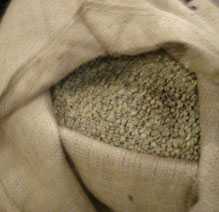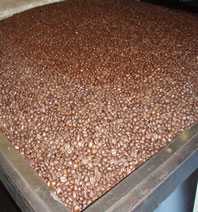FLAVORINGS-RELATED LUNG DISEASE


Coffee Processing Facilities
Workplace Interventions
Personal Protective Equipment
Personal protective equipment (PPE) is the least effective means for controlling employee exposures. Proper use of PPE requires a comprehensive program, and calls for a high level of employer and employee involvement and commitment to be effective.
- If air sampling results show levels of diacetyl and 2,3-pentanedione above the NIOSH RELs, respirator use is recommended until air sampling evidence shows a reduction in air concentrations through engineering and administrative controls. Respirators should be NIOSH-certified with organic vapor cartridges and particulate filters. The level or assigned protection factor (APF) of the respirator will depend on the air sampling results. A respirator’s APF refers to the maximal level of protectiveness a specific respirator design can achieve under laboratory conditions. For reference, half-face air-purifying respirators have an APF of 10, and full-face air-purifying respirators have an APF of 50. There are powered air-purifying respirators (PAPRs) that have APFs of 25, 50, or 1000. The OSHA APFs can be found in Table 1 of the OSHA Respiratory Protection Standard (29 CFR 1910.134) (https://www.osha.gov/pls/oshaweb/owadisp.show_document?p_id=12716&p_table=STANDARDS).
- Because air levels of diacetyl and 2,3-pentanedione may fluctuate from day to day based on production schedules, we recommend air sampling for diacetyl and 2,3-pentanedione over multiple days to ensure the APF for the respirator used is protective on all work days.
- Workers should be medically cleared to wear fit-tested respirators. Good respirator fit testing helps ensure that a worker achieves protection as close to the APF as possible. A fit factor is the ratio of contaminants outside versus contaminants inside the respirator facepiece as actually measured during a quantitative fit test. Appendix A of the OSHA respiratory protection standard (29 CFR 1910.134) details the mandatory fit-test protocols. For tight-fitting respirators (such as half-face and full-face negative-pressure air-purifying respirators) also ensure that workers perform a “user seal check” (positive and negative pressure checks) each time they wear their respirator. The procedure is outlined in Appendix B1 of the OSHA respiratory protection standard.
- Respiratory protection programs should meet the requirements of the OSHA respiratory protection standard (29 CFR 1910.134).
- Page last reviewed: January 27, 2016
- Page last updated: February 8, 2017
- Content source:
- National Institute for Occupational Safety and Health Respiratory Health Division


 ShareCompartir
ShareCompartir